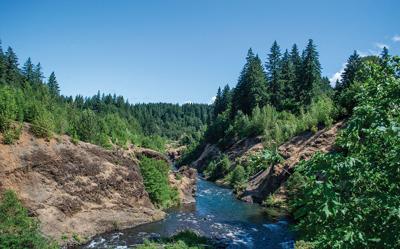HUSUM — The Yakama Nation is one step closer toward obtaining 174 acres of their ancestral territory along the White Salmon River, just above the decommissioned Condit Dam.
“The river was shackled by Condit Dam, and it disrupted a whole world of processes and natural cycles,” said Jeanette Burkhardt, watershed planner for Yakama Nation Fisheries. “The native folks who lived along Condit Dam when it was built were not consulted. They were not compensated for the loss of their livelihoods, their fishery.”
Late last month, the Conservation Fund, a nonprofit that protects natural and historic areas nationwide, announced it had purchased the property from PacifiCorp, the dam’s operator. Gates Watson, vice president of the nonprofit’s Northwest and Mountain regions, hopes to see the land under permanent Indigenous ownership within the next year. It stretches from the former dam site past Northwestern Lake Road, just a few miles south of Husum, and includes riparian areas on both sides of the White Salmon.
“The acquisition creates opportunities for tribal members to again steward the land, which includes exercising their treaty rights to fish along the waterway and having a clear connection to that river in that location,” said Watson. “Those are all really important issues for our organization.”
Completed in 1913, the 90-foot-thick, 125-foot-tall behemoth created a reservoir called Northwestern Lake and blocked chinook salmon, coho salmon and steelhead from migrating upstream. Engineers made three attempts to construct a fish ladder, and the last was swept away in 1925, effectively cutting the White Salmon in two for nearly a century.
Prior to colonization, annual salmon and steelhead returns in the Columbia River ranged from 11-16 million fish, according to the Columbia River Inter-Tribal Fish Commission. Between 2014-2023, however, data shows that an average of 2.3 million fish completed the journey, in large part due to the basin’s 14 mainstem hydroelectric dams and hundreds of smaller ones.
In the 1990s, Condit’s license was up for renewal, and to continue operations, the Federal Energy Regulatory Commission mandated that PacifiCorp install a fish ladder. The utility estimated it would be three times more expensive to make the necessary upgrades than it would be to remove Condit entirely, so on October 26, 2011, PacifiCorp breached the dam. Burkhardt remembers that day very clearly.
“It was like watching geologic change on a real-time scale that was just mind-boggling,” she said. “We could see the water draining out, and these huge walls of accumulated sediment calving off into this river channel and 80-foot logs just cartwheeling.”
At the time, decommissioning Condit was the largest dam removal project ever attempted in the United States.
“Yakamas have fished and lived along this river for millennia, stewarding the basin’s resources. Returning these riverside lands to Yakama stewardship helps restore a lost balance and brings things full circle for all its inhabitants,” Jeremy Takala, chair of Yakama Nation Tribal Council’s Fish and Wildlife Committee, said in a press release.
Watson and the Conservation Fund made the $3 million purchase from PacifiCorp primarily so the Yakama Nation would have more time to fundraise and buy the land themselves. According to Burkhardt, the confederation of tribes has already secured money from several state programs and may use some funds from their settlement with PacifiCorp to meet that threshold, alongside other sources.
“This moment really marks a win for the region in restoring and protecting the river,” said Watson.
Taking out Condit Dam laid bare the sterile, swampy land beneath Northwestern Lake. While PacifiCorp was responsible for restoring all lands affected by the dam, the Yakama Nation agreed to rehabilitate 2.8 acres of the now-drained reservoir. With the help of more than 500 community members since work began in 2013, they threw down mulch, reintroduced critical soil nutrients and planted more than 7,000 plants, shrubs and trees.
“It took a long time for things to really sort of hit their stride, but now some of those plants out there are putting on growth. They’re starting to flower and produce seed, and there’s some soil building processes starting,” said Burkhardt.
With 45 miles of uninterrupted river, fish biologists with the United States Geological Survey have also found juvenile coho and steelhead in all tributaries upstream of the dam site, according to Columbia Insight.
Although some were originally opposed removal, Watson emphasized the Cabin Owners of Northwestern Lake Association have been supportive of the nonprofit’s purchase. The Yakama Nation has yet to develop a formal management plan for the land, but they intend to maintain public access via trail, preserve the area from additional development and continue to improve the habitat.
“Rivers have an inherent right to exist and not to be impounded, used to remove waste and all the various things that we’ve done to them. Dams don’t just block water,” said Burkhardt. “They create something that is not a river anymore.”























Commented
Sorry, there are no recent results for popular commented articles.